
Author: Lawrence Lee, mintventures
1. Key points of the report
1.1 Core Investment Logic
1.2 Major risks
1.3 Valuation
2. Basic project situation
2.1 Project business scope
2.2 Team situation
2.3 Financing and important partners
3. Business Analysis
3.1 Industry space and competitive landscape
3.2 Token model analysis
3.3 Risk
4 Valuation level
1. Key points of the report
1.1 Core Investment Logic
Gelato has been deeply engaged in the field of developer services for many years and has formed a relatively complete developer service suite, which is expected to achieve business breakthroughs in combination with the RaaS services they launched at the end of 23 years.
The RaaS project has entered a period of intensive issuance. Altlayer, Dymension, and Saga have all issued coins recently. In addition, there are Conduit and Caldera with excellent financing backgrounds on the track. The RaaS track is expected to gain continuous market attention in the future.
1.2 Major risks
Difficulty in obtaining income.Gelato’s two main businesses: smart contract automation and RaaS business model determines that it is difficult to obtain revenue.
The competitors are strong.Chainlink in the field of smart contract automation, Altlayer, Conduit, Caldera and Dymension in the field of RaaS all constitute Gelato’s strong competitors, and Gelato’s competitive advantage is not strong enough.
Token use cases are thin.
1.3 Valuation
Since the revenue data on the track in which Gelato’s main business is generally unavailable, we cannot provide an accurate valuation.
From the perspective of circulating market value and fully circulating market value, Gelato’s current market value is attractive compared to its competitors.
2. Basic project situation
2.1 Project business scope
2.1.1 Automate
Regarding Gelato, Mint Ventures once published a research report in December 2019. Interested friends can go and check it out.
At that time, Gelato’s main business was “automatic execution of smart contracts”, which is to say more specifically, “whenconditionWhen A occurs, make the smart contract execute Boperate”, the products/features it has launched are as follows:
-
AMM limit order (A=token price reaches a certain value, B=trade).Gelato’s price limit order service has launched its own product Sobert Finance, which is also directly integrated by PancakeSwap, QuickSwap (Polygon Maximum Dex), and SpookySwap (Fantom Maximum Dex) on the official page, showing the partners’ recognition of Gelato products.
-
Loans are free to liquidate (A=The LTV of the loan reaches a certain value, B=Retrieve the collateral, swap the collateral as a debt, and repay the debt).This feature of Gelato has launched the C-end product Cono Finance, which also obtained Aave’s Grants because of this feature and was integrated into Instadapp.
-
In response to Uniswap V3’s position management tool G-UNI (A=token price reaches a certain value, B=adjust the LP market-making interval), MakerDAO added GUNI’s USDC-DAI LP as a collateral that can generate DAI in September 2019., GUNI’s TVL rose to nearly $2 billion at one point.In 222, Gelato independent GUNI as Arrakis Finance and is preparing to issue coins separately. However, with the focus of MakerDAO business shifting to RWA in 222, Arrakis’ TVL has dropped significantly.
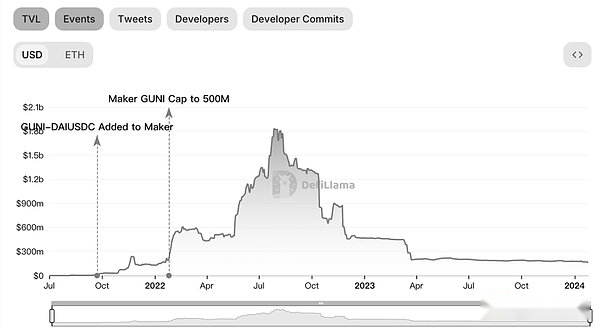
In addition to the above three typical functions, Gelato’s Automate also has many other use cases, which are also used by many DeFi projects: such as helping the Yield Framing protocol to automatically obtain profits, update oracles, etc.

Overall, Gelato’s automation business provides many useful products to crypto developers and users, and brings many conveniences.
Gelato plans to upgrade the automation service to “Web3 Function” in June 2024, which will support more triggering conditions, allowing developers to execute on-chain transactions based on arbitrary off-chain data (API/subgraphs, etc.) and calculations.The trigger condition is stored on IPFS and finally submitted to Gelato for execution.
2.1.2 Rollup as a service
Gelato officially launched the Rollup as a service (hereinafter referred to as RaaS) service at the end of 2023.RaaS can help developers choose the right technology stack, so as to easily deploy a Rollup.With the rapid development of ETH L2, the top L2 projects have launched their own open source frameworks (Optimism launched OP stack, Arbitrum launched Arbitrum Orbit, and Polygon launched Polygon CDK) to help developers quickly deploy a Rollup.Therefore, a large number of third-party service providers like Gelato have emerged to assist developers in dealing with “some blockchain-related needs”.
Although RaaS is an emerging track, the current competition is fierce. We will analyze it in detail in the 3.1 industry space and competitive landscape.

Gelato’s RaaS service has been integrated into many infrastructure service providers:
Integrates OP stack, Polygon CDK and Arbitrum Orbit in the execution layer
Integrate Ethereum, Celestia and Avail in the DA layer
Integrating Layerzero and Connext in cross-chain
Integrate Redstone, Python and API3 in oracle
Integration of The Graph and Goldsky in terms of indexing
Other fiat currency payments integrate Moonpay and Monerium, KYC services integrate Fractal ID, wallet services integrate Safe, etc.
Basically, except for Chainlink, which competes with Gelato, Gelato has completed integration with most infrastructure service providers, which can provide developers with a relatively comprehensive suite.
Gelato’s RaaS currently has 2 users: Astar Network ($ASTR) and Lisk ($LSK). Astar network completed a $22 million financing led by Polychain in January 2022. It is a famous public chain in Japan and they plan to use it.Gelato’s RaaS service launches zk Rollup based on Polygon CDK; Lisk is an old-fashioned application chain project, which recently announced its transformation to ETH’s L2.
Another user in the extension is Ape. Gelato has already proposed a proposal at ApeDAO’s governance forum. He wants to become ApeChain’s RaaS service provider and is currently in the discussion stage of the governance forum.
2.1.3 Relay
Gelato launches Relay service in 2021.Relay services allow protocols to pay gas instead of users, thus lowering the threshold for introducing users into the Web3 world.
Some typical use cases include:
To help NFT users mint NFT without gas, Zora uses Gelato’s Relay function.
Help cross-chain bridge protocol users do not have gas cross-chain, and specific users include Connext Network and Kinetex.

According to information provided by IOSG, from 2022 to 2023, nearly half of Gelato’s business volume came from Relay, and Relay’s network’s revenue became a key source for teams to survive the bear market.However, the Gelato team did not disclose the revenue from Relay services.
2.1.4 Other infrastructure services
Gelato also provides many other infrastructure services, such as:
Verifiable Random Function (VRF, Verifiable Random Function) provides verified random number services to the encrypted world, and can be used by games, NFT and other projects.
Account Abstraction, smart wallet built according to ERC-4337 standard
Multi-chain payment service 1Balance.1Balance can help developers deal with various payment issues more easily, and also supports payment for all Gelato’s businesses.
The above infrastructure services are also integrated into Gelato’s RaaS components.After years of hard work in the web3 developer service industry, the rich development kits brought by them may have a major advantage over other RaaS competitors.
2.2 Team situation
Both Gelato’s co-founders, Hilmar Orth (X: @hilmarxo) and Luis Schliesske (X: @gitpusha), are developers, and the core features of Gelato’s products were written by them.The two of them have been close friends since college and have worked together since then. Before Gelato, they also co-founded a startup focused on helping large European companies explore new business models using smart contracts.Later, they participated in a series of hackathons such as ETHParis, ETHBerlin, ETHCapetetown, and Kyber Defi Hackathon, and achieved good results and influence.It is also because of this that they got Gnosis and MetaCartel Grants and founded the Gelato Network.
According to Linkedin information, the Gelato team has a total of 29 people, which is a medium-sized encryption team. Judging from the recruitment situation on the official website, the team has a strong willingness to continue to expand in BD and the market.
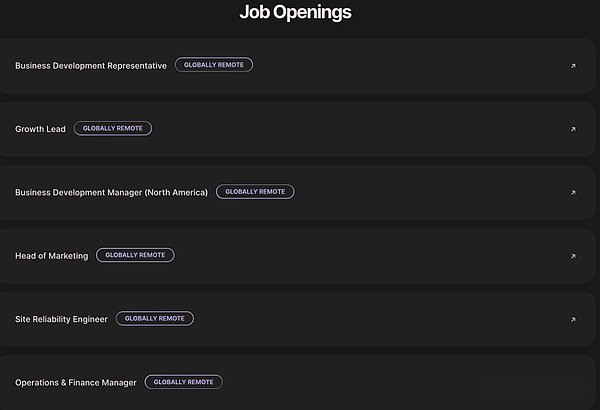
Judging from past developments, Gelato can provide more useful products, but it has not invested much in BD. According to the post of the Governance Forum, their total budget in marketing and BD in 2022 is only US$103,600..
The importance of investment in infrastructure projects in BD and marketing can be clearly seen from the development history of Chainlink and Polygon.Whether we can effectively increase investment in BD and marketing may be a key point in Gelato’s subsequent development.
2.3 Financing and important partners
Gelato has raised 4 rounds of fundraising, including 3 rounds of private equity and 1 round of public equity. The specific situation is as follows:
The seed round occurred in September 2020, raising $1.2 million, with investors: IOSG, Galaxy Digital, D1 VC, The LAO, Ming Ng, MetaCartel, Christopher Jentzsch.The corresponding $GEL cost for this round of fundraising is US$0.019.
In September 2021, Gelato announced a $11 million fundraising fundraising, investors: Dragonfly, Parafi, IDEO, Nascent, Stani Kulechov (founder of Aave). The corresponding $GEL cost for this round of fundraising is US$0.2971.
The public offering also raised $5 million in September 2021, and the corresponding $GEL cost for this round of fundraising is also $0.2971.
In December of the past 23 years, Gelato completed an expanded round of financing, led by IOSG, and did not disclose the amount of financing and financing methods.
In addition, when the project was initially established, they received Gnosis and MetaCartel Grants.
In terms of partners, since Gelato is in the developer service industry, it also provides RaaS services to the outside world, and they have many partners, which we have basically listed above.
In addition, Gelato once won the winner of Most Valuable Builders iii of BNB Chain in 2021.
3. Business Analysis
3.1 Industry space and competitive landscape
We will mainly analyze the two parts of smart contract automation services and the RaaS market.
3.1.1 Smart contract automation service
Regarding the market space and competitive landscape of smart contract automation services, we have already made detailed analysis in previous articles. Our views have not changed at present. Here we only excerpt the core views:
There are widespread scenarios in the world of Web3 that require automatic execution of smart contracts, such as regular reinvestment returns, regular wage payments, liquidity rebalancing, etc.For developers, it takes a lot of labor and time to design and execute a complete set of monitoring, computing and running programs by themselves, and automation service providers can help developers avoid “repeated wheels”; for service providers such as Gelato, etc.In terms of the situation, the marginal cost of providing services to new users is very low. There is no difference between Uniswap’s limit order and Quickswap’s limit order, so the cooperation between the two parties here is more “economic” for both sides and the business logic is solid.
However, the problem may be that, because in essence, the threshold for these services provided by Gelato is not high, and the fees that developers are willing to pay are relatively limited. The difficulties they encounter in practice may be very similar to those encountered by web2 automation service provider IFTTT: “Yes,”There are useful products, but not many people are willing to pay for them.”
In the field of smart contract automation, two are currently widely used, Chainlink and Gelato.Although the Keeper network ($KP3R) created by Andre Cronje once focused on this market, as time goes by, Keeper network has basically withdrawn from this field, and the main use case of KP3R tokens has also become acquiring Fixed Forex protocol revenue.
According to IOSG disclosure, Gelato currently has an 80% share in the smart contract automation market, and it is not easy to gain an advantage in the market segment participated by Chainlink, the leader in Web3 infrastructure.But unfortunately, the high market share does not bring stable revenue. The current product is in a state of “welcome but not popular”, and commercialization is a bit difficult.
From a competitive perspective, although Gelato entered this market earlier than Chainlink and occupies the leading position in the current market, in the medium and long term, Chainlink has a more powerful brand and a more urgent developer access channel compared to Gelato., with a richer team funding reserve and cross-selling with other own services, it is not easy for Gelato to stay ahead of the competition with Chainlink.
3.1.2 RaaS
RaaS is a relatively popular sub-track in the field of infrastructure for 23 years. Recently, with Altlayer launching Binance’s Launch Pool, the track has attracted much attention from the market.
With the rapid development of ETH L2, the scalability problem that ETH once faced seems to have been largely solved through Rollup.Especially after the upcoming Dencun upgrade is completed, the cost of Rollup will be reduced to orders of magnitude again, which makes Rollup begin to have a certain promotion foundation for large-scale commercial use.
The Ethereum system currently has the most complete infrastructure in the web3 field (including wallets, browsers, oracles, indexes, etc.), and the user experience in the EVM system is also the most widely accepted among current web3 users.For application developers, it is a good choice to create a chain to handle many “mistakes” related to the operation of the chain, making it a Rollup for ETH, so that they can focus on the application itself.
On the one hand, we see that Coinbase, Consensys, Mantle, Blur and other teams that have made very good results in other fields of web3 have chosen L2 when building a chain in 2023 (the corresponding one is Binance in 2020., OKX both built L1).
On the other hand, we can also see more and more of our own L1 decisions to be converted to Rollup, including:
Celo, a stablecoin project that is somewhat similar to Luna, proposed in July 23 to transition them to ETH’s L2
Lisk, founded in 2016, announced in December 23 that it used Gelato services to transform into ETH’s L2
We expect this trend to continue in the future.In the process of developers building Rollup, there are still a series of problems and trade-offs that need to be considered by developers, such as how to choose a Rollup that suits their characteristics, how to build and run a Sequencer, how to solve MEV problems, what kind of oracle and index to chooseetc.As a “integrated service provider” directly for developers, RaaS service providers obviously have relatively stable needs under this background.
In November 23, Binance released a research report on the RaaS track, which mainly mentioned five projects: Conduit, Altlayer, Caldera, Gelato and Lumoz. The other four projects can be said to have direct competition with Gelato.

The above protocols can be regarded as the Ethereum ecosystem. In fact, for developers, their goal is to create an application chain that is more in line with their needs. They don’t really care whether this chain is Rollup or Cosmos’ IBC chain..Although the Ethereum system has relatively complete infrastructure, the Ethereum system is not the only option.
Based on the above reasons, we also regard the “one-click chain distribution” service provider of the Cosmos ecosystem as Gelato’s competitors.Gelato’s competitors in RaaS or AppChain as a service are as follows:
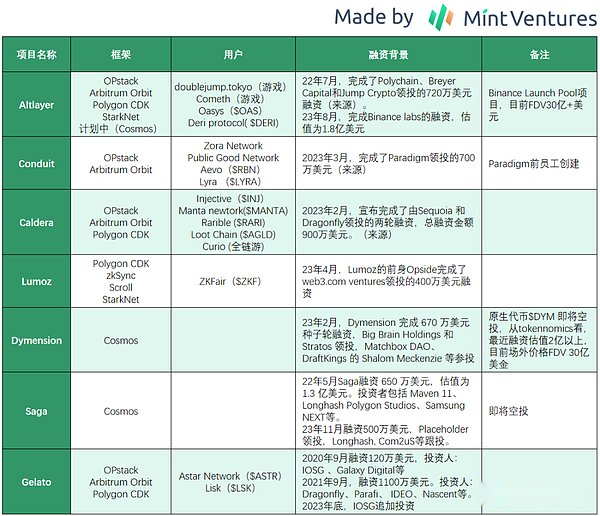
(In fact, there are also participants in the RaaS field such as Astria, Gateway.fm, Karnot, Snapchain, Vistara, Zeeve, etc. We will not give a detailed introduction due to space limitations.)
From the above project information, we can see that although the RaaS track is an emerging track, there are already many players on the field, and the top VCs have already participated in the RaaS project, and the competition is fierce.Since the second half of 23 years, more and more protocols for deploying Rollup using RaaS, and in addition to Altlayer, there are also Cosmos-based Dymension and Saga that are about to issue coins, and the entire track has entered a small climax.
Judging from the current Rollups of RaaS, it seems that there is no charge for providing RaaS services themselves. Several RaaS service providers hope to gain more value from future derivative services.
To explore how the RaaS track can obtain revenue, we take Optimism as an example to understand Rollup’s revenue and cost structure:
The Gas paid by Rollup users are generally paid to the following three layers:
Execution layer.The execution layer directly faces the user, charges the Gas fee paid by the user, and pays fees to the DA and the settlement layer.
DA layer.The DA layer ensures data availability for Rollup, which is the main destination for users to pay gas and the main cost of L2 projects. In addition to Ethereum, DA also provides DA with the recent fires, Celestia, Polygon’s independent Avail and Eigenlayer.
Settlement layer.The problem with the settlement layer is that the cost can be captured is relatively small. Optimism currently only pays Ethereum a settlement fee of about 0.05 ETH (source) every day (source).
For Optimism and any other Rollup, its revenue = execution layer revenue, expenditure = DA expenditure + settlement layer expenditure, gross profit = execution layer revenue – DA expenditure – settlement layer expenditure.
First of all, from the perspective of cost items, the settlement layer is very small. Optimism currently only pays Ethereum a settlement fee of about 0.05 ETH per day.

Then from the perspective of total revenue, due to the high DA costs, Optimism’s “gross profit” space is not large.

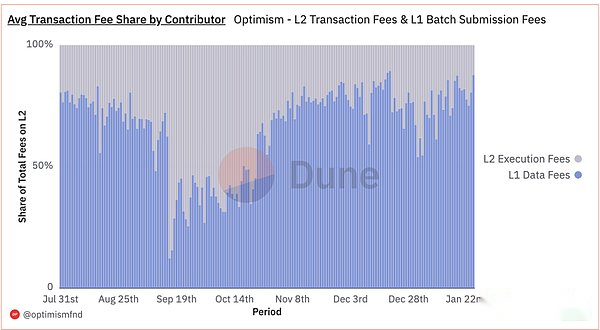
We can see that DA has made the most profits in the entire Rollup ecosystem.As RaaS service providers, if they want to obtain income, they need to draw another 10% from the above-mentioned “gross profit” of Optimism (= execution layer revenue-DA cost-settlement layer cost), which is generally relatively difficult.
Judging from the current comprehensive information, the possible ways in which RaaS acquires revenue/captures value include:
Get more profits at the execution level by hosting sequencers, MEVs, etc., which is also the most reasonable and most likely source of profits.
Gain profits by becoming a settlement layer of Rollup/Appchain (such as Dymension)
The fee is not charged through user transactions, but through the integration of other infrastructure such as wallets, browsers, or other technical consulting services.
Subscription fees similar to traditional SaaS
Of course there is also the Restaked rollup that Altlayer recently cooperated with Eigenlayer to achieve. They use $ALT more as an economic bandwidth to capture value for tokens through a combination of Restking, but this value capture is in line with the RaaS services it provides.It has little connection.
Overall, since RaaS actually has fewer projects, the income acquisition method has not yet been determined.butBy earnings for RollupCost structureAccording to the analysis, it is difficult to obtain RaaS income..
In terms of competition, since the users of RaaS service providers are developers/project parties, how to attract developers/project parties is the main focus of RaaS service providers.Although different RaaS service providers have different technical characteristics, the services that RaaS service providers can provide are largely determined by the underlying framework, so we believe that the services provided by RaaS service providers generally show obvious homogeneity.Characteristics.
Under relatively homogeneous service content,The influence of the project itselfIt may be an important factor in determining.
For projects that have not issued coins, it mainly depends on the investment capital.On the one hand, endorsement of the investment book can greatly reduce the psychological threshold for developers/projects and improve their possibility of using services.On the other hand, Ling Investment has rich developer/project resources in the industry, which can bring a natural customer base to RaaS service providers.We can see that Conduit users show obvious Paradigm-based features.
For the coined RaaS project, the market value of its project is a simple quantitative indicator of its influence.
For RaaS projects with good influence,The team itselfBDabilityThis is the key factor that determines the ceiling of RaaS projects in the long run.
In a market like RaaS that seems to be a blue ocean but may actually be close to the red ocean, compared with its competitors, Gelato does not have an advantage in terms of influence and BD capabilities. Its advantage lies more in the team’s expertise in the field of developer services for many years.This allows for a more comprehensive suite of development tools.
3.2 Token model analysis
The total amount of $GEL of Gelato Network’s governance token is 420,690,000, and its allocation is as follows:

50% is allocated to community development (later after the governance vote in March last year, 20% is left for further financing)
4% allocated to public offerings conducted in September 21
21% were allocated to private equity investors, and the investors’ tokens were released half in September 2022 and September 2023 respectively (later after a governance vote, the tokens originally scheduled to be released in September 23 advanced to February 23release).
25% are allocated to the team, of which 15% are allocated to the current team; 10% are allocated to the future team.The team’s tokens will be released 25% after one year of locking in, and the remaining part will be released linearly in three years.
According to the lock-up terms, the part of the public and private equity investors has been circulated, and the community part locks 27% of the tokens, and the remaining 15% of the team’s tokens are in lock-up state, with the overall circulation ratio of 58%.
Through analysis of on-chain data, we found that among private equity investors, the four addresses including IOSG and Dragonfly have not sold their $GEL tokens, and the above four addresses hold a total of 12.4% of $GEL.
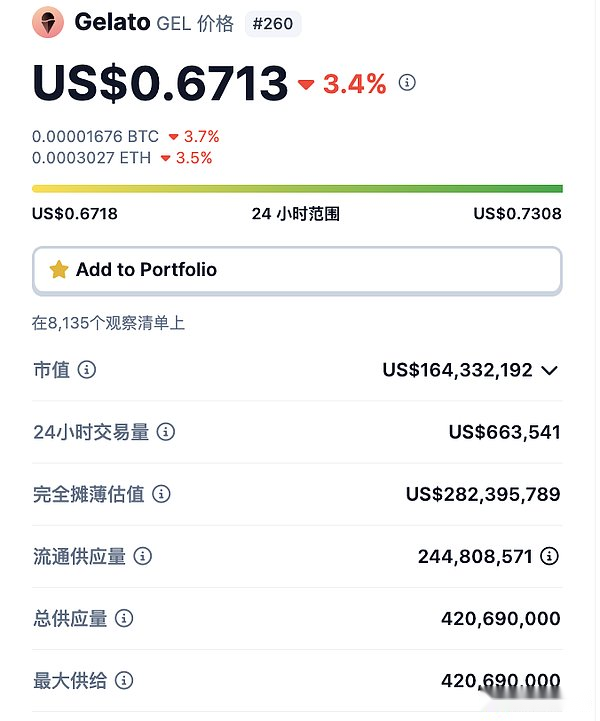
Currently, GEL’s circulating market value is US$164 million and its full circulating market value is US$282 million.
According to official documentation, the use cases for $GEL are governance and staking.
But in fact, since its launch, Gelato has not many things to manage, and there are only 10 votes on Snapshot; $GEL does not have a real online staking function (except for 22 years of pledging $GEL to obtain Arrakis’ governance tokens).
Overall, $GEL’s token use cases are relatively thin.
3.3 Risk
Gelato has the following risks:
Difficulty in obtaining income: Whether it is smart contract automation or RaaS business, its business model determines that it is difficult to obtain income.
Strong competitors: Chainlink in the field of smart contract automation, Altlayer, Conduit, Caldera and Dymension in the field of RaaS all constitute Gelato’s competitors. Compared with its competitors, Gelato’s competitive advantage is not strong enough.
4 Valuation level
Whether it is smart contract automation or RaaS, we cannot obtain accurate revenue data for projects on the track, so we cannot accurately value them. Here we mainly list the circulation market value and market value of several projects that form a competitive relationship with Gelato.The full circulating market value is for your reference.

5. Reference content and thanks
https://www.neelsomani.com/blog/rollups-as-a-service-are-going-to-zero.php
@IOSGVC recently completed the lead investment in @gelatonetwork 's extended round at the end of 2023. As one of Gelato's earliest supporters (co-lead the seed round with @galaxyhq in 2020), we have had the privilege to witness the rapid growth of @hilmarxo , @gitpusha and rest… pic.twitter.com/gnphIix94c
— Ray Xiao (@_RayXiao) January 4, 2024
https://mirror.xyz/hismrti.eth/I-aOI7SfOItFb51prXpX3hhy-3_9EYu-jaMdIsQExXc
https://mirror.xyz/hismrti.eth/SOq1l9dU-rWOd_pUoUZZAHIJDf_SuBudRZO8ux-3XNw
https://www.neelsomani.com/blog/rollups-as-a-service-are-going-to-zero.php








